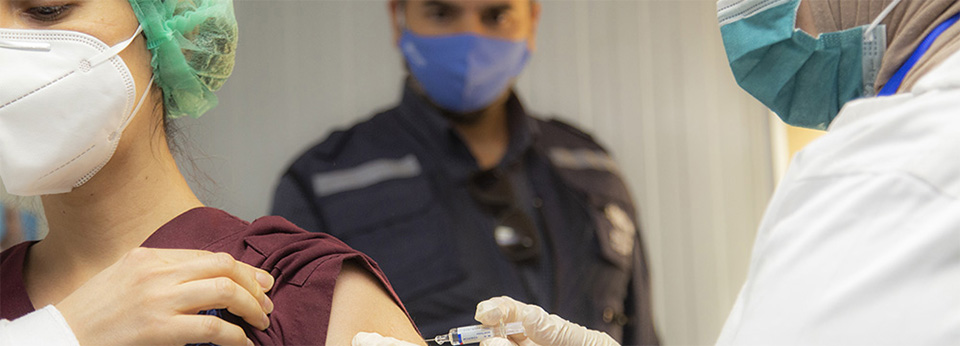 Photo credit: WHO/Syria
Photo credit: WHO/Syria
26 January 2021 – The Vaccine Request Form - Part A of the COVID-19 vaccine application document was signed by the Minister of Health and sent to GAVI - the Vaccine Alliance on 15 December 2020. Part B (the legal part) is still awaiting Ministry of Health approval (with WHO follow up).
1. Coordination framework established
All the necessary coordination committees (National Coordination Committee, cTAG COVID-19 Technical Advisory Group and ICC Inter-Agency Coordination Committee) along with their adjusted terms of reference have been approved by the Government of Syria.
2. National readiness assessment
VIRAT/VRAF version updated tool includes planning and coordination, budgeting, regulatory, prioritization, targeting and surveillance, service delivery, training and supervision, monitoring and evaluation, vaccine cold-chain, logistics, safety surveillance, and demand generation and communication – a set of 50 key operational activities:
- First update was submitted at the end of November 2020.
- Second update was submitted on 14 January 2021.
- Third update was endorsed by the Ministry of Health on 20 January 2021.
3. Establishment of taskforces
To bridge capacity and planning and implementation gaps and to ensure preparedness regarding key areas of vaccine introduction, 10 sub-committees were formed as the technical part of the cTAG committee (WHO and UNICEF as focal points are included). Meetings take place regularly to update the VIRAT and to prepare the needed materials for the national vaccine deployment plan.
4. Population prioritization
The following high-risk groups were agreed upon as a target under COVAX (the denominator - all Syrian population):
- Health workforce (including front line social workers and teachers), 3% of population;
- Older adults >55-year population, about 13% of population;
- People with chronic diseases, 5% of population.
At present the national authorities collect and consolidate population data (including from the Ministry of Planning, civil society organizations, Syndicate of Doctors and health workers at national and governate levels). The population data include all 14 governorates of Syria, including the north-west and north-east Syria. The Ministry of Health highly relies on the existing mechanisms and modalities related to the previous experience of the routine immunization activities across these governorates.
5. Pre-registration mechanism
The Ministry of Health works over the adaptation of the pre-registration mechanism. This could be applied for identification of the second priority target group after reviewing all the possibilities, benefits and challenges.
6. Service delivery mechanisms
At this stage, 75 service delivery points are planned to provide vaccination, including 62 fixed facilities (hospitals) all over the country and 13 mobile teams. This number of facilities and teams is preliminary and is subject to change based on the ongoing microplanning. Each hospital will have 3 or more teams assigned to the microplanning for each stage of the campaign. Services will be provided by the trained hospital teams and by routine immunization personnel as part of the mobile teams. Implementation across northeast Syria will follow the current experience of EPI microplanning through fixed and mobile teams. Formal and informal settlements will be targeted as well through the same modalities. WHO may support transportation of the vaccine to northeast Syria and coordinate the mobile activities on the ground with different stakeholders, based on the existing operations.
WHO Syria maintains a direct day-to-day dialogue with WHO Turkey. WHO Gaziantep office together with UNICEF have submitted COVAX applications relying for the implementation on the currently existing immunization programme modalities in northwest Syria. There are plans to support to cover about 20% of the Syrian population in northwest Syria. The prioritization was made based on series of discussions among the parties involved and will include health care workers, the elderly and people in the age group 18–59 with special conditions such as immune compromised persons and persons with chronic illnesses. More information will be provided at later stage.
7. Development of the national deployment vaccination plan
- Deployment of 2 WHO consultants (international, national) is in progress.
- Training of 2 consultants on national vaccine deployment plan has been finalized this week.
- The plan is proposed to be finalized by the end of February 2021.
8. Guidelines, forms, reporting materials
Work is ongoing to develop the following:
- Vaccination cards, vaccination registers, reporting forms;
- Monitoring and supervision checklist;
- Adverse events following immunization guideline, checklist and reporting forms;
- Updating COVID-19 reporting forms to include vaccination;
- Infection prevention and control and waste management protocols;
- Communication materials.
9. Cold chain
- Nationwide cold chain inventory is ongoing. UNICEF contracted a consultant to review and enhance this component.
- A desk review was conducted.
- A specific tool is being used to identify gaps and needs.
10. Vaccination in high-risk areas
The Ministry will use mobile teams in the first stage to vaccinate health workers in hard-to-reach areas.




